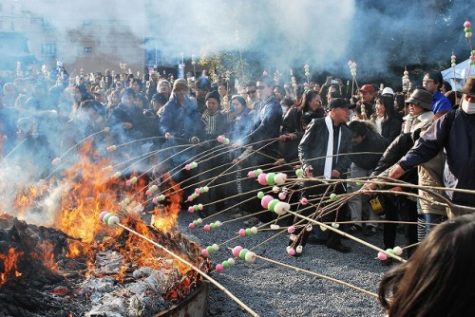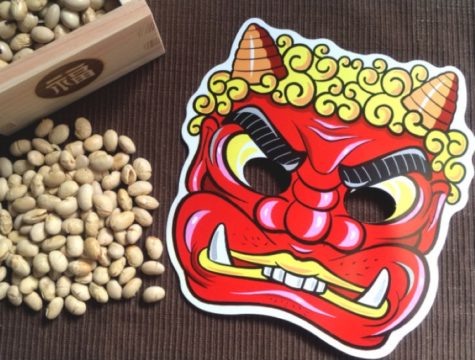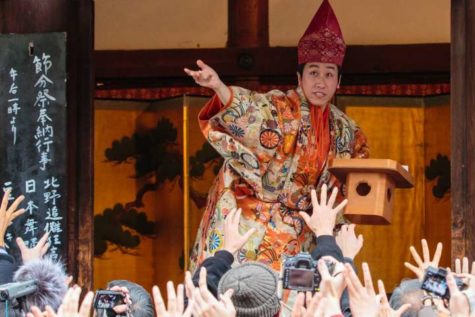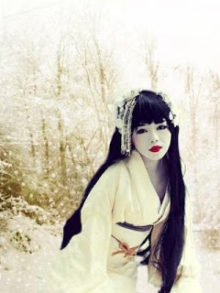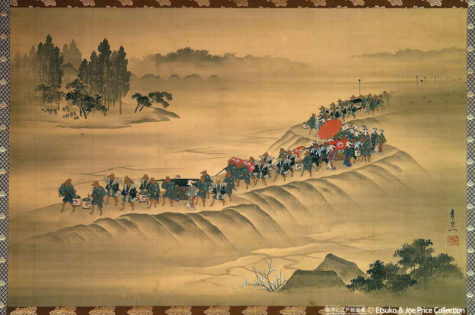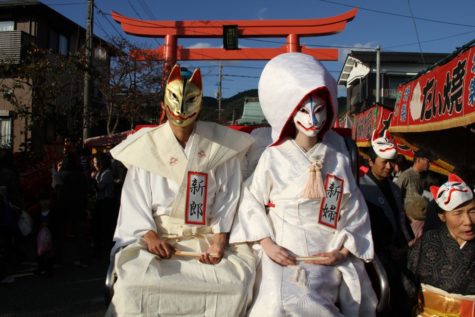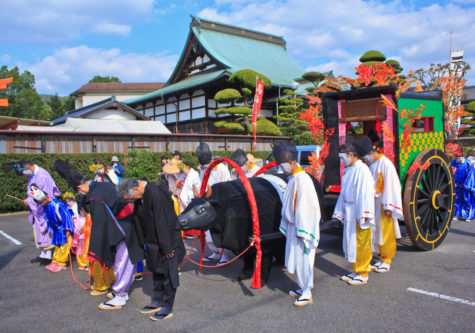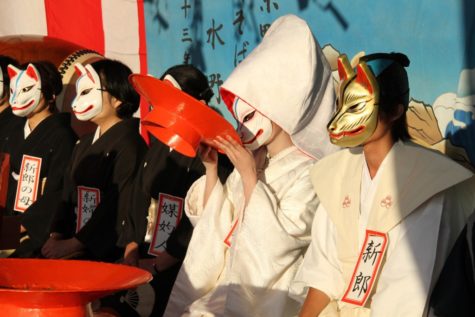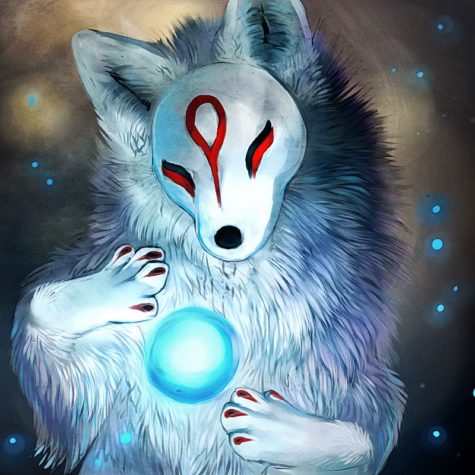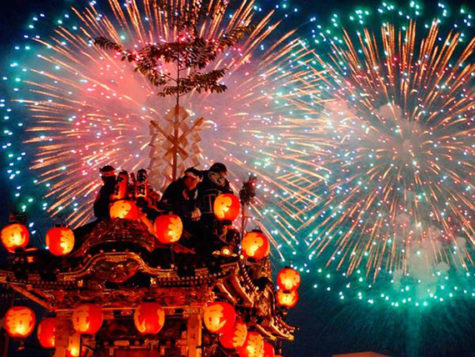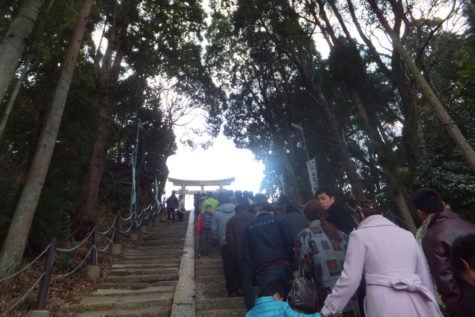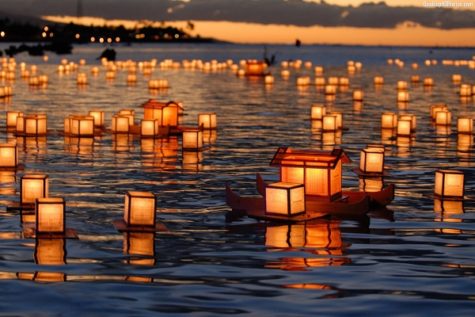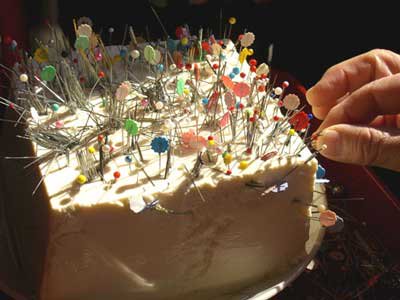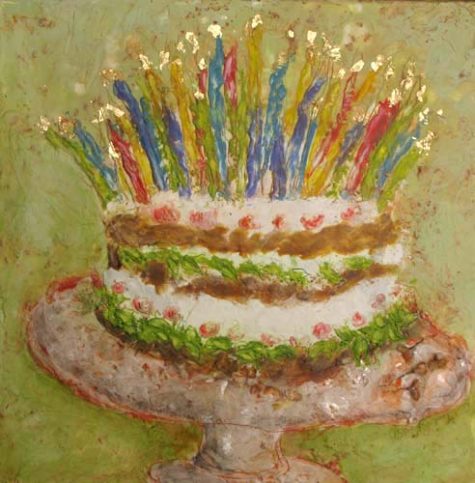Japan
In Tabayama Village of Kitatsuru District, Yamanashi Prefecture, a (a Fire Festival dedicated to the Dōsojin or the deity of pathways and roads practiced throughout Eastern Japan. The festivity called Dondoyaki, and is celebrated between 14th and 15th January.
In this festivity, the villagers gather their Mayudama Dumplings, decorative rice dumplings made for the Japanese New Year and suspended from lines or tree tweeds. These are cooked over a bonfire and then eaten. Eating those dumplings is believed to prevent cavities, while the heat from the bonfire makes the person healthy for the rest of the year. Ashes from the fire can be used as snake and disease repellent as well as fire hazard preventative.
Japan has four distinct seasons: spring, summer, autumn, and winter. The term setsubun originally referred to the days marking the change from one season to the next, so that there were four of them, but today only the day before risshun (the beginning of spring in the traditional Japanese calendar) is called by that name. Setsubun comes on either February 3 or 4, depending on the year.
On the night of Setsubun, many households do mame-maki – a bean-throwing ceremony. The toshiotoko of the household (a male born on the corresponding Chinese zodiac animal of the year), or the male head of the household, throws pan-heated soybeans out the door, while chanting:
“Oni wa soto!
Fuku wa uchi!”
“Demons out!
Luck in!”
After the mame-maki is over, everyone eats the same number of beans as their own age. It is believed that by doing so, people will be free of sickness during that year.
Mame-maki began as a New Year ceremony (in the traditional Japanese calendar) to drive out evil spirits and the seeds of misfortune, as well as to pray for the family’s well-being and good business. In the Heian era, a famous Buddhist monk was said to have driven away Oni (demons or evil spirits) by throwing beans.
Oni masks are popular. Oni are mountain ogres with horns; fangs; red, blue, brown or black skin; and carry weapons.
Families with little children especially look forward to this day because mame-maki can be a lot of fun. One person acts as the goblin and runs around, while the others throw beans at the person. At some schools, the students make goblin masks and enjoy mame-maki.
At Buddhist temples and Shinto shrines all over the country, there are celebrations. Priests and invited guests will throw roasted soy beans (some wrapped in gold or silver foil), small envelopes with money, sweets, candies, and other prizes for people to catch.
Some families put up hiiragi iwashi (holly sardine), small decorations made from cooked sardine heads (sometimes the whole fish) stuck onto holly branches. They are placed on the entrance to the home so that bad spirits may not enter.
A traditional food is Eho Maki, a sushi roll made with seven “lucky” ingredients. Though sushi rolls are usually sliced into bite-sized pieces, Eho Maki is not, as slicing it would cut off good fortune. A wish is made, then the roll is eaten in silence while facing the year’s lucky compass direction. The direction changes each year. Ginger sake is a customary drink.
From 365 Goddess:
- Themes: Luck; Protection; Cycles; Happiness
- Symbols: A Snowflake; Beans
- Color: White
- Presiding Goddess: Shirata
About Shirata:
This Japanese goddess embodies the first snow, where she glistens and shines with incomparable beauty until she freely and joyfully gives herself to spring’s warmth and melts away. By so doing, Shirata reminds us that while the year has only just begun, the wheel of time is ever moving, and that we should make the most of every moment.
To Do Today:
For happiness, cut a snowflake pattern out of a quartered piece of white paper and carry it with you in your wallet as a charm. Make sure to visualize the snowflake being filled with brilliant white light, like that which is seen when the sun shines off new-fallen snow.
In Japan, this day (Setsubun) is a time to chase away any malevolent influences that might hinder Shirata’s joyful nature within us. People scatter beans and make loud noises to banish evil and carve lanterns with wishes to light the way for a better tomorrow. For our purposes, scatter seeds on the ground or plant beans instead so something as beautiful as Shirata can replace any negativity in your life with abundant growth.
To internalize Shirata’s happiness, prepare any white beans and eat them as part of a meal today. If you hold any rituals, use beans to mark the magic circle, scattering them counterclockwise to banish any unwanted influences.
From: Web Holidays and 365 Goddess
Most stories advise against seeing a fox wedding—foxes are powerful in Japanese folklore, but dangerous. A wise person keeps well away, and getting wrapped up in Kitsune magick is rarely healthy in Japanese folklore.
If you remain undeterred, and really want to see a Fox Wedding, according to the folklore of the Fukushima Prefecture, it can be done, but only on the 10th day of the 10th month of the Lunar Calendar. (In 2019, this falls on November 6).
- Here’s what to do:
Wear a suribachi mortar on your head and stick the wooden pestle in your belt. Then stand under a date tree. The length of time is unspecified… I’m assuming for however long it takes.
Aichi prefecture has a much easier method—just spit in a well and weave your fingers together. You are said to be able to view the Kitsune no Yomeiri though the gaps in your fingers.
More about the Fox Spirits known as Kitsune can be found at The Powers That Be, a story about a fox wedding can be found on Widdershins. A Fox Wedding festival is held annually in Japan on November 3rd. You can read about that in The Pagan Calendar.
Source: Hyakumonogatari Kaidankai
Many towns hold Kitsune no Yomeiri festivals re-creating the famous processions. Most of these festivals are modern—coming from the 1950s to as recently as the 1990s—and were started as tourist attractions to draw people into town. Local politicians and businesses participate in the festival, and sometimes the fox bride and groom are selected as a sort of “beauty pageant.”
Not all are modern tourist traps, however. The festival in Kudamatsu city, Yamaguchi prefecture, has also been held since ancient times, although it bears little relationship to popular images of the Kitsune no Yomeiri. It involves asking the blessing of a pair of white fox deities whose wedding ceremony is re-enacted every year.
Kitsune no Yomeiri has been an event and Shinto ritual at Inaho Festival since 1950. People who wear fox masks walk at the old street slowly to the final destination – Hanaoka station.
Fox bride and groom ride on a Jinrikisha (a pulled rickshaw), and relatives and attendants dressed in the crested kimono – hakama follow and walk after a Jinrikisha. A Jinrikisha is a two-wheeled vehicle which is pulled and run by a rickshaw driver. It had been used widely in Japan before an automobile was invented.
After fox couple’s arriving at the Hanaoka station, the ceremony called “San San Ku Do” (three-three-nine times) exchange of nuptial (marriage) cups takes place.
What is “San San Ku Do”?
“San San Ku Do” is a ceremony between bride and groom, where they sip sake three times from three sake cups. The sizes of three cups are different. One is a small cup, another is a medium cup, and the other is a large cup.
- Small cup stands for the past.
Drinking from a small sake cup intends to express thanks to ancestors who gave the chance for a couple to meet.
- Medium size cup means the present time.
Drinking from this one stands for the intention of the couple to live together for a long time and helping each other.
- Large size cup means future.
By drinking from a large cup, the couple hopes that both families will be happy in the future with prosperity of both families’ descendants.
The public never knows who play the roles of foxes’ bride and groom. According to a legend, it is said that a person who became a fox bride will find a good partner to get married.
Why Do People Worship Foxes Here?
According to a legend, there was a chief priest in Hory-ji temple. He was known as the person who had high virtues and was loved by people.
One day, he went out, and the on the way back to his temple, he noticed that his rosary (praying beads) was missing. He tried to look for his praying beads, but he could not find it in the dark. He could not do anything and slept in his bed.
When he was sleeping, a white fox appeared in his dream. The fox said to him:
“We are a couple of white foxes who were dead in woods, we will bring your praying beads back to you this evening, if you take our corpses back to your temple and bury us in the same way as human beings. We also promise you to protect the people of your temple and village from misfortune”.
The priest woke up soon.
Surprisingly, there was the rosary he lost by the pillow. After that, the priest found corpses of white foxes, and buried carefully. Since then, people who are looking for something, or who lost something, have been coming to pray here. And actually many of them found what they were looking for.
Sources:
One of the most popular holidays in Japan, Kodomo-no-hi or Children’s Day is celebrate on May 5th. Though it is called Children’s Day today, this holiday is celebrated as “Boy’s Day”. The fifth day of the fifth month is traditionally called Tango no Sekku. Girls have their own festival, called Hina Matsuri (Doll Festival), held on the third day of the third month.
On Kodomo-no-hi families drive bad spirits away and celebrate the prospects of their son’s future. Warrior samurai dolls are put on display in the home.
Koinobori, carp streamers, are flown on flagpoles and from balconies. The carp was chosen because it symbolizes strength and success; according to a Chinese legend, a carp swam upstream to become a dragon. In recent years, as more people have moved into apartments and smaller houses, the carp streamers have also gotten smaller, and there are now miniature versions that are decorated indoors.
Children participate in syobuyu, an ancient ritual, by taking a baths in which the water is sprinkled with iris leaves and roots. This is because the iris is thought to promote good health and ward off evil. Also on this day, families often take Rice cakes wrapped in oak leaves and filled with sweet bean paste, called kashiwamochi, are also eaten.
All these figures: the carp, the samurai, irises, oak trees, and bamboos symbolize strength and courage.
Sources:
Shinto holy day marking a new year. On this day the faithful visit shrines to thank the kami (spirits within objects in the Shinto faith), ask the kami for good fortune, and make resolutions for the year ahead.
Traditionally, Shinto practitioners observe this New Year holiday by visiting the shrines, mostly at midnight and praying for the renewal of their heart, prosperity and health in the year to come. It is also common to visit close friends and family to express good wishes.
This festival concentrates on the deep unrecognized awareness and respect for the divine energy that permeates all forms of life. It is one of the most significant yearly festivals in Shintoism.
Though the New Year is predominantly celebrated on the first day of the year, traditionally the Shinto’s celebrate Gantan-sai for a prolonged span of seven days.
Much like Christmas for Christians, Gantan Sai has become a national holiday in Japan and expanded out past the Shinto religious practices and evolved into a national holiday. It is referred to as the Japanese New Year or Shogatu .It is observed on the first day of the Gregorian calendar i.e. the 1st of January and is the annual New Year celebration of the Shinto religion.
Originally, the date of the Japanese New Year was decided according to the Chinese Lunar Calendar and the date varied each year. However, in 1873, five years since the Meiji Restoration, the people of Japan adopted the Gregorian calendar and fixed the date of Japanese New Year or Shogatu to be the 1st of January every year, and it has been so ever since.
Traditions and Practices:
During this festival, most Shinto’s spend the holiday by visiting sacred Shinto temples at the hour of midnight.
During this visit, they wear their finest clothes and pray that their hearts be renewed and purified of all dirt and uncleanliness.
- Blessings for health, happiness and prosperity are also requested for the upcoming year.
- This festival also witnesses friends and families coming together to wish well for each other.
On this day, people eat traditional food with their families. Gantan-sai day meals involve a special compilation of dishes known as “Osechi”. The typical New Year Day menu comprises of dishes like Ozoni a soup, Mochi with vegetables, Kamabokoa puree of steamed white fish, Kurikinton mashed sweet potato with chestnut and Kuromame sweet black beans.
Source: Gatan-sai
According to Japanese Buddhist belief, every summer at this time spirits of the dead return to visit their families. O-Bon is a Buddhist ceremony for welcoming back and appeasing the souls of our ancestors.
During the course of this festival, the souls of the dead are guided home, feted for several days, and then sent back to the spirit world.
The formal name of this festival is Ura-Bon, and generally falls on Aug 13 thru Aug 15. Depending on the region, however, the Bon Festival may be held one month earlier, or July 13th-15th.
The word O-Bon has its roots in the Sanskrit word ullambana, which means ‘deliverance from suffering’. The festival combines early Buddhist rituals designed to rescue the souls of the dead from hell, with native Japanese agricultural rites and the Shinto tradition of welcoming back the souls of ancestors in late summer.
Traditionally, the bones of the deceased are placed in individual urns and kept with their ancestors in a family tomb (ohaka). For several consecutive evenings during the week of O-Bon, paper lanterns painted with the family crest are hung to guide the ancestral spirits to the ohaka.
Alternatively, small welcoming fires (mukaebi) may be lit at the entrance to the home, or in front of the gate early on the evening of the 13th to receive the souls of the ancestors.
It is also customary at this time to clean the family grave and present fresh flowers and incense. Those who are unable to travel to their family burial place may instead spruce up the domestic altar. Houses are cleaned and decorated and a place is sometimes set at the family table for the recently departed.
Although many Japanese also hold Shinto beliefs, it is Buddhism that is associated with rituals concerned with death. Therefore it is the Buddhist household altar — the butsudan — that remains the focus of attention during O-Bon.
Offering stands and a small tray with tiny dishes for the symbolic meals offered to the ancestors are brought out, and a special shelf (Shoryodana or ‘Shelf of Souls’) is set up in front of the altar; it is here that, for the duration of O-Bon, the spirits are believed to dwell.
At the end of three days (on the 16th), the lanterns are again set out to guide the spirits back, and an okuribi (farewell) fire is lit to see off the souls of the ancestors.
Collected from various sources including Mythic Maps
Because the warm weather continues, activity levels are high, even though the days are beginning to shorten. Consequently, numerous festivals during this month focus on family, friends, and social interaction.
For magical purposes, July directs our attention to personal growth and improvements. This includes increasing your knowledge, continuing efforts for prosperity, creating new ideas and works of art, and also taking time out periodically to really enjoy yourself. Our society sometimes mistakes much-needed leisure time for laziness but this months’s energies know better. Go and have fun, carrying the Goddess with you for a little extra energy.
July Correspondences:
- Nature Spirits: hobgoblins (small grotesque but friendly brownie-type creatures), faeries of harvested crops.
- Herbs: honeysuckle, agrimony, lemon balm, hyssop
- Colors: silver, blue-gray
- Flowers: lotus, water lily, jasmine
- Scents: orris, frankincense
- Stones: pearl, moonstone, white agate
- Trees: oak, acacia ash
- Animals: crab, turtle, dolphin, whale
- Birds: starling, ibis, swallow
- Deities: Khepera, Athene, Juno, Hel, Holda, Cerridwen, Nephtys, Venus
Power flow:
Relaxed energy; preparing, succeeding. Dream work; divination and meditation on goals and plans, especially spiritual ones.
July Festivities:
At first the Romans called this month Quintilis, but later renamed it Julius after Julius Caesar, who was born in this summer month. The Greek Olympian was held for about a week in July. This festival in honor of Zeus consisted of competitions in athletics, drama, music, and other activities. During the time of the Olympian, all participants were given safe-conduct to and from the games. The constant petty Greek squabbles were put aside. A victory in the Olympian was a great achievement, both for the individual and for their city.
Two of the Roman holidays held during this month were July 8 – 9 when the Goddess Juno was honored and the Neptunalia on July 23, when Neptune, the god of the seas and earthquakes, was placated.
In Japan, the Full Moon of July saw the O-Bon, or Festival of Lanterns. This was a combination of Buddhist and Shinto beliefs that honored the dead. Homes, tombs, and ancestral tablets were thoroughly cleaned. Altars and shrines were decorated. The gardens were hung with lanterns to light the way of the dead so that they could join with their families for the three-day ceremony.
The Egyptian New Year fell in July, as did the Opet Festival, which commemorated the marriage of Isis and Osiris. Their sexual union was said to bring good luck to all people. About the same time in Rome, the love of Venus and Adonis was celebrated. The Egyptian year was measured against the Nile and its yearly fertile floods. This was also the time of the birth of Isis and Nephthys, Osiris, Set, and Haroeris. These days were the ones won by Thoth for these deities; births; in other words, there were the necessary days to make the solar and lunar calendars match.
The Incas had a ceremony called Chahua-huarquiz, Chacra Ricuichi, or Chacra Cona, which meant Plowing Month. While the Northern Hemisphere was beginning its agricultural harvests with the reaping of the corn crop, the Southern Hemisphere was just beginning to break ground for planting.
Buddha’s Birth and Preaching, also called the Picture Feast, was celebrated in Tibet.
From: Moon Magic and 365 Goddess
In the Hari-Kuyo ceremony, Japanese women gather once a year on Febuary 8th at Shinto shrines or Buddhist temples to thank their worn out needles and pins for good service.
It is also a time to value the small, everyday objects of daily living and to wish for progress in one’s needle work. In what is known as the Festival of Broken Needles, women gather to offer a funeral-type service by laying the needles to rest in soft jelly cakes or tofu. This burial is meant to bring rest to the needles and wrap them with tenderness and gratitude. This practice reflects the animist belief that all beings and objects have a soul.
Another aspect of the ceremony is the consideration for “the value of small things.” The concept of Mottainai, or not being wasteful, is related to the usefulness of the needles. These small but important tools would give long, useful service throughout the year. They were not to be lost or wasted nor carelessly replaced.
Further to the idea of laying the needles to rest for good service is the idea that women have many secret sorrows in life. These sorrows are often passed to the needles during long hours of stitching and the needles are thought to take on the burden of some of these sorrows, thus taking them away with the stitching that they do. This “rest” is brought to the needles in appreciation for their faithful service.
Source: Stitchtress Stumbles
The seventh day of the Chinese New Year, traditionally known as Rénrì (人日, the common man’s birthday), is the day when everyone grows one year older. In some overseas Chinese communities in Southeast Asia, such as Malaysia and Singapore, it is also the day when tossed raw fish salad, yusheng, is eaten for continued wealth and prosperity.
This day is filled with omens about human fate. For example, any person or animal born on this day is considered doubly blessed and destined for prosperity. So, consider taking out a divination tool today and seeing what fate holds for you.
In Chinese mythology, Nüwa is the goddess who created the world. She created the animals on different days, and human beings on the seventh day after the creation of the world. The order of creation is as follows:
- First of zhengyue: Chicken
- Second of zhengyue: Dog
- Third of zhengyue: Boar
- Fourth of zhengyue: Sheep
- Fifth of zhengyue: Cow
- Sixth of zhengyue: Horse
- Seventh of zhengyue: Human.
Hence, Chinese tradition has set the first day of zhengyue as the “birthday” of the chicken, the second day of zhengyue as the “birthday” of the dog, etc. And the seventh day of zhengyue is viewed as the common “birthday” of all human beings.
To generate Nüwa’s luck or organizational skills in your life, make and carry a clay Nüwa charm. Get some modeling clay from a toy store (if possible, choose a color that suits your goal, like green for money). If you can’t get clay, bubblegum will work, too. Shape this into a symbol of your goal, saying:
From Nüwa blessings poured,
Luck and order be restored.
Renri is the day, when all common men are growing a year older and the day is celebrated with certain foods according to the origin of the people. The ingredients of the dishes have a symbolic meaning and they should enhance health.
To honour Nüwa’s creation of animals either vegetable dishes will be eaten or a raw fish and vegetable salad called yusheng. Yusheng literally means “raw fish” but since “fish (鱼)” is commonly conflated with its homophone “abundance (余)”, Yúshēng (鱼生) is interpreted as a homonym for Yúshēng (余升) meaning an increase in abundance. Therefore, yusheng is considered a symbol of abundance, prosperity and vigor.
Almost no Chinese celebrate on this day. Some people just eat potatoes with angel hair noodle. The long noodle stands for longevity. In the past, seven vegetables which can repel the evil spirits and sickness away were eaten. They are as follows:
- Celery, Shepherd’s Purse Spinach, Green Onion, Garlic, Mugwort and Colewort
Ancient Chinese had a tradition of wearing head ornaments called rensheng, which were made of ribbon or gold and represented humans. People also climbed mountains and composed poems. Emperors after the Tang dynasty granted ribbon rensheng to their subjects and held festivities with them. If there were good weather on Renri, it was considered that people will have a year of peace and prosperity.
Fireworks and huapao are lit, so Renri celebrates the “birthday” of fire as well.
Since the first days of zhengyue are considered “birthdays” of different animals, Chinese people avoid killing the animals on their respective birthdays and punishing prisoners on Renri.
Nowadays in zhengyue, Renri is celebrated as part of the Chinese New Year. Chinese people prepare lucky food in the new year, where the “seven vegetable soup,” “seven vegetable congee” and “jidi congee” are specially prepared for Renri. Malaysian and Singaporean Chinese use the “seven-colored raw fish” instead of the “seven vegetable soup”.
In Japan, Renri is called Jinjitsu. It is one of the five seasonal festivals. It is celebrated on January 7. It is also known as Nanakusa no sekku, “the feast of seven herbs”, from the custom of eating seven-herb kayu to ensure good health for the coming year.
The celebration of the feast in Japan was moved from the seventh day of the first lunar month to the seventh day of January during the Meiji period, when Japan adopted the Gregorian calendar.
Sources: 365 Goddess and wikipedia
